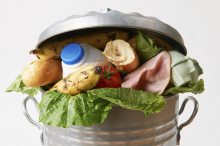
Food waste in the United States amounts to a staggering 63 million tons per year. A new report released last Wednesday now shows an achievable path to a 20% reduction of food waste within a decade through 27 cost-effective, feasible, and scalable solutions. Published by ReFED, a collaboration of business, nonprofit, foundation and government leaders committed to reducing US food waste, the report comes just a few months after the U.S. government set a national goal calling for a 50% cut in edible food waste by 2030. According to the “Roadmap to Reduce US Food Waste”, the U.S. spends more than $218 billion a year or 1.3% of GDP growing, processing, transporting and disposing food that is never eaten. Each year, 52.4 million tons of food is sent to landfill, and an additional 10.1 million tons is discarded or left unharvested on farms. This food waste consumes 21% of all fresh water, 19% of all fertilizer, 18% of cropland and 21% of landfill volume. The measures proposed in the report would require $18 billion of investment over the next decade but would yield a net economic value to society of approximately $100 billion over the same period through consumer savings on lower food bills, additional meals donated to the hungry, and additional values of reducing greenhouse gas emissions. “Reducing food waste is one of the most tangible ways we can all help contribute to a healthier planet. What is so exciting about the Roadmap is that it clearly identifies actions that can be taken today, which will provide immediate economic benefits to consumers and businesses,” said Sarah Vared, interim director of ReFED. The proposed solutions prioritise prevention first, then recovery, and finally recycling. According to the authors, solutions that prevent waste in businesses and homes have the greatest economic value per ton and net environmental benefit, diverting 2.6 million tons of annual waste. Prevention measures include conducting large-scale advocacy campaigns to educate consumers about ways to prevent food waste, modifying packaging sizes and standardizing food label dates, including eliminating visible “sell by” dates to reduce consumer confusion. Opening retail stores that sell discounted groceries, such as the supermarket recently opened in Denmark which sells unsold food donated by supermarkets and businesses at a lower price, are another way to prevent waste. Food recovery by redistributing food to people could increase by 1.8 billion meals annually, nearly doubling the amount of meals rescued today and diverting 1.1 million tons of waste. Recycling by repurposing food waste as energy, agricultural and other products also offers a huge savings potential. Measures include composting or feeding food waste to animals. The report claims the implementation of the proposed 27 solutions could avoid nearly 18 million tons of greenhouse gas emissions annually and could save the country 1.6 trillion gallons of fresh water. (ab)
